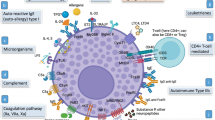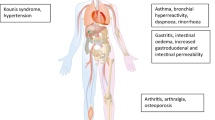Abstract
Chronic urticaria (CU) is characterized by recurrent itching skin eruptions caused by mast cell degranulation. Relapses can be provoked by food intake. The aim of this study was to investigate if the mast cell number in the gastroduodenal mucosa is increased in CU patients, and whether mast cell counting by pathologists is clinically useful. We defined two study groups: 50 disease controls (16 Belgians and 34 Italians) and 43 Belgian CU patients. Mast cells were detected using immunohistochemistry for tryptase and CD117. The mast cell number in the disease controls was 20.2/high-power filed (HPF; 133.3/mm2) in the stomach and 32.5/HPF (209.2/mm2) in the duodenum. There was no difference between Belgian and Italian controls, indicating that dietary habits have no influence on the normal gastroduodenal mast cell number. In CU patients, mast cell numbers were significantly higher: 32.4/HPF (186.0/mm2) in the stomach (P<0.0001) and 44.8/HPF (246.0/mm2) in the duodenum (P=0.0002). CU is thus associated with mast cell infiltration in the gastroduodenal mucosa, even if patients do not have gastrointestinal symptoms. Mast cell counting in gastroduodenal biopsies of CU patients can be useful in selecting patients who may respond to a therapy with intestinal mast-cell-stabilizing agents.




Similar content being viewed by others
References
Augustin M, Karttunen TJ, Kokkonen J (2001) TIA1 and mast cell tryptase in food allergy of children: increase of intraepithelial lymphocytes expressing TIA1 associates with allergy. J Pediatr Gastroenterol Nutr 32:11–18
Bagnato GF, Di Cesare E, Caruso RA, Gulli S, Cugliari A, Morabito Lo Prete A, Previti M, Muscara M, Bottari M (1995) Gastric mucosal mast cells in atopic subjects. Allergy 50:322–327
Beil WJ, Schulz M, McEuen AR, Buckley MG, Walls AF (1997) Number, fixation properties, dye-binding and protease expression of duodenal mast cells: comparisons between healthy subjects and patients with gastritis or Crohn’s disease. Histochem J 29:759–773
Bruno G, Andreozzi P, Magrini L, Graf U, Santangelo G, Zaino S (2001) Mast cell activation in acquired chronic urticaria–angioedema. Sci Total Environ 270:77–81
Buhner S, Reese I, Kuehl F, Lochs H, Zuberbier T (2004) Pseudoallergic reactions in chronic urticaria are associated with altered gastroduodenal permeability. Allergy 59:1118–1123
Caproni M, Volpi W, Macchia D, Giomi B, Manfredi M, Campi P, Cardinali C, D’Agata A, Fabbri P (2003) Infiltrating cells and related cytokines in lesional skin of patients with chronic urticaria and positive autologus serum skin test. Exp Dermatol 12:621–628
Crivellato E, Finato N, Isola M, Ribatti D, Beltrami CA (2003) Low mast cell density in the human duodenal mucosa from chronic inflammatory duodenal bowel disorders is associated with defective villous architecture. Eur J Clin Invest 33:601–610
Debeuckelaere S, Schoors DF, Devis G (1991) Systemic mast cell disease: a review of the literature with special focus on the gastrointestinal manifestations. Acta Clin Belg 46:226–232
Dixon MF, Genta RM, Yardley JH, Correa P (1996) Classification and grading of gastritis. The updated Sydney System. International workshop on the histopathology of gastritis, Houston 1994. Am J Surg Pathol 20:1161–1181
Ferguson J, Thompson RP, Greaves MW (1988) Intestinal mucosal mast cells: enumeration in urticaria pigmentosa and systemic mastocytosis. Br J Dermatol 119:573–578
Furusu H, Murase K, Nishida Y, Isomoto H, Takeshima F, Mizuta Y, Hewlett BR, Riddel RH, Kohno S (2002) Accumulation of mast cell and macrophages in focal active gastritis of patients with Crohn’s disease. Hepatogastroenterology 49:639–643
Gemmel E, Carter CL, Seymour GJ (2004) Mast cell in human peridontal disease. J Dent Res 83:384–387
Haas N, Toppe E, Henz BM (1998) Microscopic morphology of different types of urticaria. Arch Dermatol 134:41–46
Hidvegi B, Nagy E, Szabo T, Temesvari E, Marschalko M, Karpati S, Horvath A, Gergely P (2003) Correlation between T-cell and mast cell activity in patients with chronic urticaria. Int Arch Allergy Immunol 132:177–182
Kozel MM, Sabroe RA (2004) Chronic urticaria: aetiology, management and current and future treatment options. Drugs 64:2515–2536
Li CY, Dry SM (2004) Are c-kit and mast cell tryptase more effective at identifying mucosal mast cell in GI biopsies? Mod Pathol 17(Suppl 1):121A
Liutu M, Kalimo K, Kalimo H, Uksila J, Leino R (2004) Mast cells and IgE-containing cells in gastric mucosa of Helicobacter pylori infected and non-infected patients with chronic urticaria. J Eur Acad Dermatol Venereol 18:69–72
Nakajima S, Krishnan B, Ota H, Segura AM, Hattori T, Graham DY, Genta RM (1997) Mast cell involvement in gastritis with or without Helicobacter pylori infection. Gastroenterology 113:746–754
Reimann HJ, Ring J, Ultsch B, Wendt P (1985) Intragastral provocation under endoscopic control (IPEC) in food allergy: mast cell and histamine changes in gastric mucosa. Clin Allergy 15:195–202
Siegert SI, Diebold J, Ludolph-Hauser D, Lohrs U (2004) Are gastrointestinal mucosal mast cells increased in patients with systemic mastocytosis? Am J Clin Pathol 122:560–565
Smith CH, Kepley C, Schwartz LB, Lee TH (1995) Mast cell number and phenotype in chronic idiopathic urticaria. J Allergy Clin Immunol 96:360–364
Staumont-Salle D, Piette F, Delaporte E (2003) Etiological diagnosis and treatment of chronic urticaria. Rev Med Interne 24:34–44
Strobel S, Busuttil A, Ferguson A (1983) Human intestinal mucosal mast cells: expanded population in untreated coeliac disease. Gut 24:222–227
Suranyi Y, Freier S, Faber J, Dollberg L (1986) Intestinal mast cells in different stages of celiac disease. Isr J Med 22:370–375
Walls AF, Jones DB, Williams JH, Church MK, Holgate ST (1990) Immunohistochemical identification of mast cells in formaldehyde-fixed tissue using monoclonal antibodies specific for tryptase. J Pathol 162:119–126
Wingren U, Hallert C, Norrby K, Enerback L (1986) Histamine and mucosal mast cells in gluten enteropathy. Agents Actions 18:266–268
Zuberbier T (2001) The role of allergens and pseudoallergens in urticaria. J Investig Dermatol Symp Proc 6(2):132–134
Author information
Authors and Affiliations
Corresponding author
Rights and permissions
About this article
Cite this article
Minnei, F., Wetzels, C., De Hertogh, G. et al. Chronic urticaria is associated with mast cell infiltration in the gastroduodenal mucosa. Virchows Arch 448, 262–268 (2006). https://doi.org/10.1007/s00428-005-0111-3
Received:
Accepted:
Published:
Issue Date:
DOI: https://doi.org/10.1007/s00428-005-0111-3




